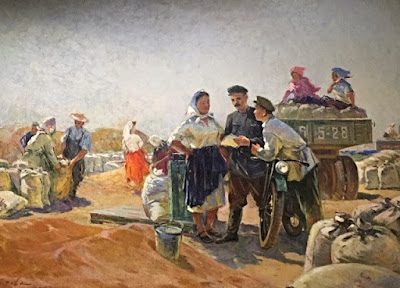 |
| Dr. Veldman Rudie provides rewarding insights on Soviet art. |
Carol Veldman Rudie has been lead docent at the Museum of Russian Art since 2005 where she is also coordinator of outreach education. It's apparent she's been putting her minor in history to good use.
In addition to the insightful lecture, those in attendance had the privilege of meeting the newly installed director of the Tweed, Dr. Anja Chávez who introduced our guest lecturer and welcomed us.
 |
| Definitely non-Utopian, post-Stalin. |
 |
| Conventional State-approved art. |
The lecture showed how there were competing styles in the art. A painting of a woman ironing, painted in a traditional style, was contrasted with a painting of a woman ironing in a non-literal style, an expressionist manner that was not correct even though the subject matter was the same.
After the Revolution abortion became legal and over time there was a declining population. (Also due to waves of starvation as well.) In response Stalin pushed artists to produce idyllic paintings of family life, with happy children, in an effort to encourage people to think favorably about reproduction.
 |
| Rich in symbols and code. Alexandr Gazhur's "Pilgrims" 1989. |
After Khrushchev we see the emergence of non-conformist art. Painters like Bulotov and Rabine addressed the degradation taking place or the covering up of Reality by the State. We were shown numerous examples of conformist and non-conformist art. The non-conformists, with paintings like "No Exit" demonstrate irony and confront us with the question of what is really true. (This, at a time when the party line was laid out in Pravda, the official propaganda organ of the State.)
 |
| Traditional landscape being obliterated by red stars. |
The Spiritual was another theme expunged under Lenin and Stalin. The Soviet Union was a Materialist culture. Spirituality was not acknowledged. There were, however, artists who incorporated the spiritual into their work. Artists like Viktor Popkov pushed the boundaries in the arena.
The art of Odessa got away with portraying Jewish life and its ways. (For what it's worth, Bob Dylan's father Abram Zimmerman's parents--Zigman and Anna--were from Odessa, emigrating to the United States during the anti-semitic pogroms of 1905.)
There's plenty to see at the Tweed if you get a chance. And with a little background like that presented last night, you will have an even greater appreciation for this Art In Conflict exhibition.
UPCOMING Lectures in this series:
February 18: Art on the Edges: Non-Conformists and Spirituality
March 24: Women in the Soviet Union: Utopian Dreams, Reality Check
April 21: The People's Papers: The Poster Tradition in the Soviet Context
Related Links
A Farce So Dark It Will Make You Laugh: The Death of Stalin (movie review)
Local Art Seen: Tweed Spotlights the Art of Russia










No comments:
Post a Comment